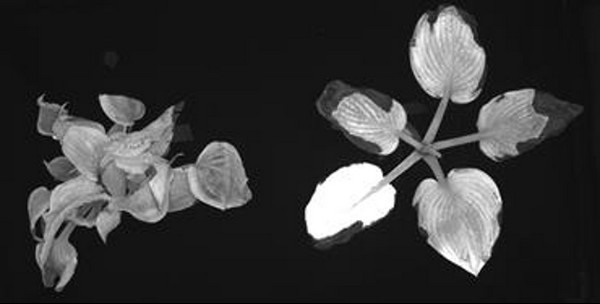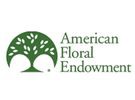Stress-free plants = less stress for growers and retailers. Two AFE-funded research projects from scientists at the University of Georgia are currently underway that investigate new ways to detect and reduce plant stress from abiotic pressures and diseases before they happen.
Here’s what the researchers have to say after this past year of funding:
Fluorescence imaging: a low-cost method for early stress detection
Marc van Iersel, UGA
Objective: Develop and test a novel approach for the detection of plant stress before visible symptoms are present.
Updates from year 1
Greenhouse and nursery producers face a wide range of abiotic (fertility, temperature, lack of water, etc.) and biotic stresses (pathogens, insects) that can negatively impact crop production. Early detection of these stresses is important to mitigate negative impacts on the crop. Such detection typically depends on the visual inspection of crops by an experienced grower. However, stresses can only be detected after symptoms are visible. Earlier detection of potential problems would be beneficial: the sooner a production problem can be addressed, the smaller its impact will be.
Our research uses a multi-spectral imaging system to determine chlorophyll fluorescence intensity (CFI). All photosynthetic organisms contain chlorophyll, which fluoresces. What that means is that a small fraction of the light that is absorbed by plants is given off again as red and far-red light. Yes, plants literally glow. We can’t see it because the fluorescence is too weak (only 1 – 2% of the light that hits the plant), but it is easy to photograph. We light plants using blue LEDs and then take a picture through a filter that allows only red and far-red light to pass through the lens to the image sensor—the result: an image of the light produced by the plant. We also take pictures of the plants under red and infrared light and use these images to calculate the Normalized Difference Vegetation Index (NDVI, a common index of plant vigor or greenness). We found that higher fertilizer results in higher CFI and NDVI values, as well as more uniform NDVI values throughout the entire canopy.
The imaging system also shows the potential to detect temperature stress. CFI images of hosta exposed to 23°F showed that cold damage induced extremely bright fluorescence that was easily visible.

Chlorophyll fluorescence image of two hosta plants after exposure to 23°F. The brightly fluorescing leaf, circled in red, was the only leaf to sustain serious damage.
Next year, we plan to correlate imaging data with traditional plant nutrient analysis data, further investigate CFI as a way to investigate heat and cold stress and develop an improved, open-source CFI/multi-spectral imaging system that can be assembled by non-specialists for as little as $500, with detailed instructions for hardware assembly and freely-available software.
Visit the research website and blog.
Read the full continued funding report.
Use of CRISPR to develop powdery mildew resistance in gerbera
Dayton Wilde, UGA
Objective: CRISPR-mediated knockout of Gerbera daisy MLO for powdery mildew resistance.
Updates from year 2
This project investigates the use of gene editing to improve floral crops. Our research will benefit the industry by developing gene editing methods for floral crop improvement. The ability to confer disease resistance through CRISPR technology is being examined in gerbera cultivars in the marketplace, which is not a model genotype. This complicated the research, but the results should be more relevant to implementing this technology by the floriculture industry to other floral species. In the last year, our efforts were concentrated on four areas: shoot multiplication, induction of organogenesis and somatic embryogenesis, genetic transformation, and CRISPR construct design.
Shoot multiplication
We have successfully determined the optimal tissue culture medium for shoot multiplication of gerbera cultivars ‘Flori Line Maxi Yellow,’ Revolution ‘Bicolor Red Lemon,’ Garvinea ‘Sweet Love,’ and Majorette ‘Pink Halo,’ which provided us with a source of leaf blades and petioles for tissue culture and transformation experiments.
Organogenesis and somatic embryogenesis
To produce transgenic and gene-edited plants, efficient methods for regenerating gerbera shoots from tissue culture are required. We are also pursuing somatic embryogenesis, an alternative approach to regeneration, because embryogenic tissue is a good target for biolistics (directly delivering DNA fragments into cells using a gene gun) and transgene-free gene editing. To these ends, we were able to determine the most effective shoot induction treatment for petioles and leaf blades of Gerbera ‘Flori Line Maxi Yellow’ and Majorette ‘Pink Halo,’ and potentially embryogenic callus was induced from Majorette ‘Pink Halo’ with 2,4-D.
Genetic transformation and CRISPR constructs
To determine how to introduce desirable genes (ultimately powdery mildew resistance, in this case), we use what are known as marker genes. These are foreign genes introduced whose expression provides an easily identifiable trait that lets us know that a particular cell can be transformed. There are two types of marker genes, selectable markers (commonly antibiotic or herbicide resistance) and visual markers (fluorescence or blue coloration). Selectable markers kill all but the transformed cells, while visible markers give you visual confirmation of gene transfer. We found that the hygromycin B phosphotransferase gene (HPH) was the best selectable marker for the cultivars we worked with, as opposed to other selectable markers previously used in the literature. In addition to the HPH marker, we introduced a green fluorescent protein (GFP, a visual marker commonly used to indicate transgene expression) transgene into leaf explants of ‘Flori Line Maxi Yellow’ using Agrobacterium tumefaciens C58 in a series of multi-factor experiments. GFP expression could be observed in multiple sites across our leaf explants after two weeks, indicating stable transformation. In the presence of 0.1 mg/L IBA and 2.0 BAP mg/L, regenerating tissue was obtained that expressed GFP. The GFP-expressing plants will be validated by analysis, and CRISPR constructs will be introduced.
Read the full continued funding report here.
For more information
American Floral Endowment
+1 (703) 838-5211
www.endowment.org
